
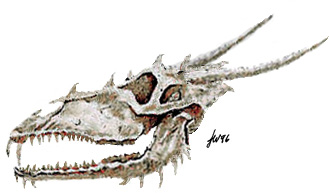
Ever wonder what a dragon looked like from the inside out?
This is a study of the physiology of a dragon created for HERE BE DRAGONS! and to share with the world how dragons may actually be part of this place we know as Earth. This is about what the dragon is made up of and what makes it unique in the animal world. Please enjoy the information here, but do not use this information on other web-sites or publications. If you must, please link instead of re-writing this information.Thanks.
THE SKELETON
The Western dragon Eudraco magnificus occidentalis has a sturdy skeleton structure. Large head, long neck, broad shoulders, thick legs, strong tail, and very large wings. The dragon's bones are very strong, but hollow and light. A dragon's jaw is large to accommodate the very strong muscles around it. The dragon is able to dislocate its jaw, as some snakes are able to do, to grab large objects. The dragon has two types of teeth because of it being an omnivore (It will eat meat and plant food). The canine and incisor teeth of a dragon are long and razor sharp, but also have molars to chew their food instead of eating it whole. The shoulder bones are thick to handle the large wing muscles needed to fly. The wing "finger" bones are very long to wrap the thin flight membrane taut around them. There are many species of Western dragon, and this is only one example showing the different bones of the skeletal system.
Take a look at the Western Dragon Skeleton System by clicking on the picture below! (size=258K)
The Oriental (or Eastern) dragon Dracoserpens Lung orientalis has a extremely long, thin skeleton structure. It has a medium sized head, very long neck, short legs, small hips, and a long tail. This skeleton is very maneuverable because of the shape, such as a long snake is. It can twist and turn its body in all sorts of ways. This type of dragon does not have hollow bones, and the dragon's skeleton is thin because it doesn't need the mass to accommodate flight muscles. This dragon does not have any type of wings as it flies with earth-magic verses brute strength.
Take a look at the Eastern Dragon Skeleton System by clicking on the picture below! (size=32K)
MUSCLES
Western dragons have many more muscles then their Eastern cousins. This is mainly due to their massive flight muscles that have to lift their weight into the sky with the thrust of their wings. The main wing muscles are the Supraspinatus and Flexor alae major. Notice that the actual wing does not have many major muscles, it is all near the chest area. Other large muscles account for a very strong tail, and rear legs. The Western dragon could easily hold a human male's weight while in flight. Also notice the large jaw muscle Masseter, this muscle can easily crush bones.
Take a look at the Western Dragon Musculature System by clicking on the picture below! (size=262K)
OUTSIDE OF THE BODY
The dragon can be a huge creature depending on the breed. The one shown here is roughly 20 feet long with a wingspan of 35 feet. This type of dragon has extremely small ears, large eyes, spines down its back, and a bone-type spade at the end of its tail. All dragon breeds are different. Some have long ears, and no spade, and some have a fleshy-type triangle-shaped spade. This type of dragon also does not have scales, it has tough leathery skin. Most dragons have scales of some sort.
Take a look at the Western Dragon Body by clicking on the picture below! (size=256K)
SCALES
Scales (and horns/claws) on a dragon are densely packed cells made up of keratin, a tough fibrous protein. When born, a dragon's scales are as soft as tissue paper, and slowly harden while the dragon grows. The iron from the blood, or vegetable matter the dragon eats is absorbed by the dragon's blood stream and mixed with the keratin to create steel-hard scales. The process of getting scales as tough as they can get takes about one year after being hatched.
COLOR
Scale color is determand by the genes of the parent dragons. Usually only red dragons will mate with other red dragons, etc. But if a mating took place between a gold and a green dragon, the result might be a bronze colored offspring. Scales on a dragon are never simply one shade of color. If a dragon is blue, there will be many, many shades of blue. Light, medium, dark, blue-black, etc. Scales are bright and shiny in a healthy dragon, but dull and muted if a dragon is ill.
CAMOUFLAGE
In some breeds of dragons when the dragon is mature, the cells in the scales are able to change color such as a chameleon due to chromatophore, the pigment cells in the scales.This reaction can be caused by emotion (anger, happiness,etc) or by the will of the dragon to change color. If the dragon is angered it can change from its original color to a bright, fierce color such as red, to look more intimidating or during mating rituals, it can flow certain color patterns on its body to attract other dragons. Since dragons are extremely intelligent, it can choose which colors to change into to match the exact background it is near including subtle shadow and highlights. It is so good at this, most things would just walk past a 65 foot dragon hiding in the sand.
A DRAGON'S ARMOR
The main function of scales is protection of the soft skin tissue of the dragon. An adult dragon can easily take a direct blow from a knight's sword and hardly flinch. Adult dragons have 4-6 inch wide, and 7-9 inch long teardrop shaped scales covering its body. The pattern of the body scales is a flat, rotating design that overlap each other. Easy movement is due to the unique depression on the top side of each scale that allows them to lay evenly flat on the body.
The scales on the chest area are the largest; easily being over a foot wide. The chest scales are one to three flat "scale flaps". These are shaped differently than a regular scale as they are more squarish. The pattern of the chest scales is overlapping and flat running from the throat, under body to the end of the tail. All of the scales lightly slide over each other, so when a dragon walks it will make a soft scraping sound. The overlapping scales make it difficult for anything to successfully injure a dragon.
An interesting fact is that the dragon can make the scales stand on end for washing. Also, when angered, the dragon can puff up, spread its scales, and look a lot larger than the dragon actually is. Lifting the scales is also an effective heat reducing element. Making the scales stand on end allows the skin underneath to release heat, thus cooling the large animal down quickly. A favorite past-time of dragons is to stand the scales up and go into a cool pool of water to allow it to run in between the scales and onto the sensitive skin.
THE WING
The wing. The part of the dragon that distinguishes itself from all other creatures. The dragon wing is a huge, leathery appendage that is found on several different species of dragon. The wing is usually larger than the dragon's body to accommodate the incredible force needed to lift and maintain flight.
BONES
The wing is essentially another arm and hand. If you look at the skeleton of a dragon front arm and claws, you will notice that the wing is just a very stretched out version. The two thick "arm bones" (humerus and wing radius) runs from the body of the dragon attaching itself with cartilage and muscle to an "elbow" of the wing. There are usually 4 or 5 elongated "fingers" on a wing each ending in a claw. One short "thumb" claw is at the "wrist". The "fingers" then attach themselves to the "wrist joints" to form the complete wing.
HOW DO THEY FLY?
Thanks to
Windseeker for the flying dragon animation
The actual force of flight is the continuous down sweep of powerful wings scooping, and thrusting the body upwards. An immature dragon does not have the strength needed for a vertical jump from flat ground to take off. They will usually stay near higher cliffs to use the heat updrafts to keep aloft. It takes a few years of flying to build the extremely strong flight muscles needed to lift the dragon body from the ground. The wings make actually look small for the mass of the dragon, but all dragons have an innate magic ability to help them fly. This magic helps keep dragons from straining themselves during long flights.
WEAPONS
Dragons can also use their wings as an attack weapon if need be, but this is a last resort. The wing membranes are easily damaged compared to the rest of a dragon body. If a dragon wing membrane is slashed, it takes a very long time to heal, and there is a chance the dragon might never fly again if it does not heal correctly. If attacked on the ground, the dragon will usually run then jump in the air and fly off avoiding the attacker. But if the dragon is trapped on the ground it will tuck its wings tightly against its body and use its breath weapon and claws to protect itself. If the dragon has to use its wings to attack it will scoop down and slash with its razor sharp wing claws to immobilize the attacker.
SENSES
Dragons have the same senses as humans; sight, hearing, smelling, touch, and taste. But some have a six sense which is being able to "read" the emotion of another being. Their regular five senses are incredibly sensitive. For example, the sense of smell is about 100 times more sensitive than a bloodhound dog. They can smell and hear a person or animal from a couple miles away!
Their six sense is very accurate at close range. If a person or animal is feeling a strong emotion, such as fear or hate, it will register very strongly to the dragon, even if it is not in visual range of it. This is where dragonfear comes from. Dragonfear is an all encompassing, frozen-in-place fear that the dragon causes upon the animal or person seeing a dragon. The dragons sometimes use this advantage to beat its foes, such as thieves or knights. Only the very bravest (or very dim-witted) are not affected by this terrible fear. This is usually an aura around evil-minded dragons, but in a friendly dragon, such as the Faerie Dragon, this aura is non-existant.
THE FIRE BREATHERS!
Fire: the thing that makes the dragon most feared. It's a hellish belch of flame that can turn flesh and bone into ash. Though, not all dragons breath fire. Some have freezing cold breath, others have acid, and some don't use their breath as a weapon at all! The two that have fire breathing power are the Red Dragon and Fire Drake.
HOW DO THEY BREATH FIRE?
It all starts when the dragon catch their prey. When dragons eat, they digest the food in a regular stomach. The digestion then continues in a second stomach that breaks down the food even further. After the dragon's body has used all it can from the second digestion, the body then turns the leftover food and acid into a byproduct of hydrogen. The dragon can hold the hydrogen in various large glands in it's body for later use, and can call upon it at any time it needs to. When the dragon needs to belch it's flame, the glands release the hydrogen into the lungs where it mixes with other various chemicals the body creates. Once this mixture finds oxygen, it burns extremely hot, and very quick. The dragon usually has enough hydrogen in its body for about three spits of flame, but that should be plenty for anything coming up against a large red dragon. This explanation is about the same for dragons that breath other types of breath. Their bodies just break down food into different compounds. For another explination of firebreathing, please
read this explination by Firefenix.
CONCLUSION
I hope you enjoyed your little trip into the physiology of a dragon. Remember, all dragons are different, so if you dissagree with this study, no one can tell you that you are wrong. This is just one look at this wonderful creature and I hope that this might stir your imagination to make up your own mythology of the dragon.
Read some other explinations:
Advanced Dragon Description
The information presented here contains all the theories that I have been offered (and for a large part thought of by myself) during all these years. They explain how a creature such as dragons could be living in our world without breaking the fundamental laws that rules our universe. Here you will find no magic but only a person with a good knowledge of science pondering the countless possibilities of biological structures and organisms.
|
General Physiology
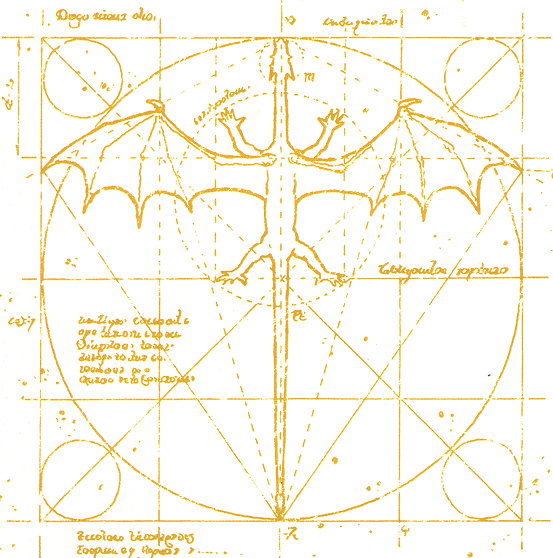 The dragon is a homoiothermic reptile. In other words, he is a warm-blooded creature and his body temperature is controlled internally. This characteristic enables him to adapt to the different climates of his very extensive habitat and to maintain his activities both day and night throughout the year, as he is not dependent on the warmth from the sun like the other reptiles. The dragon generally has wings, and his bones are hollow, for lightness. There are dragons, usually ancient survivor from the distant past, with stumpy legs and no wings. These rare survivors of a remote era are intelligent and fairly aggressive, and belong to a single species known as "worm of the deep", a species on the verge of extinction. This creature lives for a very long time. There are records of dragons who have lived for five hundred and even a thousand years, but there are no knows cases of dragons who have died from old age. On the other hand, they died from accidents, certain diseases, or as a result of the actions of their most relentless enemy: MAN. The dragon is a homoiothermic reptile. In other words, he is a warm-blooded creature and his body temperature is controlled internally. This characteristic enables him to adapt to the different climates of his very extensive habitat and to maintain his activities both day and night throughout the year, as he is not dependent on the warmth from the sun like the other reptiles. The dragon generally has wings, and his bones are hollow, for lightness. There are dragons, usually ancient survivor from the distant past, with stumpy legs and no wings. These rare survivors of a remote era are intelligent and fairly aggressive, and belong to a single species known as "worm of the deep", a species on the verge of extinction. This creature lives for a very long time. There are records of dragons who have lived for five hundred and even a thousand years, but there are no knows cases of dragons who have died from old age. On the other hand, they died from accidents, certain diseases, or as a result of the actions of their most relentless enemy: MAN.
|

The Skeleton
The dragon is the largest known flying creature. To maintain his enormous bulk in the air, his physical structure has had to be different from that of other reptiles whom many persons inaccurately associate dragon with these.
His wing bones fit on to broad shoulders which support the powerful wing muscles; these require an extraordinary articulator system unknown in other species. The bones were tougher than reinforced concrete and much lighter.
It is important to note that the bones of a dragon are hollow like bird reducing their mass, scientifically: any creature with the physiology of a dragon can flight well and at great speed.
|

The Muscular system
The dragons muscular system is one of the most fascinating... and one of the most complicate. We can evaluate the power in the bite of a dragon to put to an average of 2 ton per cm cube (in comparison it could easily gnaw steel).
As a matter of fact, dragons are very powerful. Their leg and "arm" can support great charge without much difficulty but this only applies on ground movement because in the air, a dragon could not maintain more than half of is weight for a long period of time.
If you have vision keen you probably notice something at the looking of the muscular picture and the skeleton picture... with the observation of the front and the rear paws, I come to the conclusion that dragons COULD NOT run, their muscles of the leg and arm were not developed for this matter. This doesn't means they could not walk, this only means that they could not reach great speed at ground. (Take in consideration that dragons come in so much variety that it could be possible for a dragon to run but not those who have the similar structure of the picture above).
|

The Scales
The dragon's body is completely covered with tough, shiny scales. Dragon usually doesn't have this scaly armor on the neck or stomach, possibly due to his habit of burrowing underground, not all draconologist are agreed about this. To protect his "soft" abdomen (at least weaker than the rest of his body) the dragon often wears jeweled breastplate. Using his saliva, which has powerful adhesive properties, and which he secretes on an empty stomach, the dragon often sticks precious stones on his neck and stomach, for protection as well as adornment.
The scales are pentagonal, and shaped like a teardrop, with two long sides and two shorter ones, and a very short fifth side attached to the skin. The dragon can make them stand on end whenever he likes to preen them. Remember, the dragon is a very clean creature and takes great care always to keep his skin and scales clean and immaculate.
In their normal position, the scales overlap very neatly and, thanks to a tiny cavity in the surface, they fit into each other to allow perfect freedom of movement.
If we study a scale closely, we observe the following characteristics: the innermost part is composed of a compact hairy formation firmly rooted in the epidermis. On the hair follicle there are some tiny glands which secrete a substance that adheres firmly to the skin.
This substance is rich in minerals, which determine the hardness and the color of the dragon's scales. The external surface has a horny, translucent texture, which gives the scales their habitual luster.
CROSS SECTION
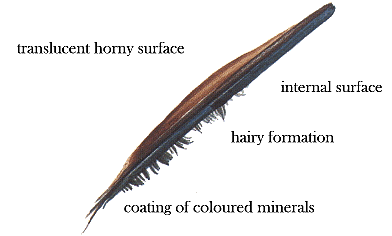
The dragon does not need to sloughs off his skin like most other reptiles, as the scales grow, they are renewed automatically, like human nails and hair. They are not shed from the body, except in case of illness.
FRONTAL SECTION
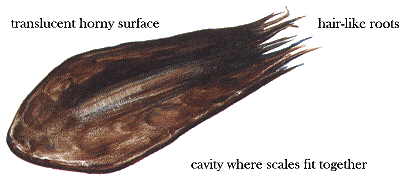 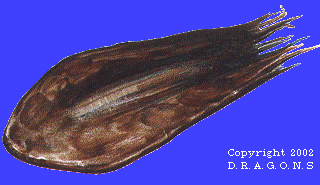
|

Wings and Flight
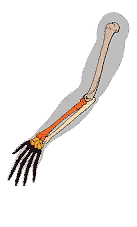 The wings of a dragon are based on the principle arm of any animal, i.e. they consist of an thumb and four very lengthened fingers, the whole connected with a membrane as we can observe in the bat. It is significant to understand that the similar struture between the shoulder, the arm and the hand is homologous with the corresponding structures of the wing for the dragon (see opposite figure). It is also important to understand that the membrane of the wing do not attaches close to the shoulder as certain biologically erroneous drawings can sometimes shown but near the bottom of the back of the dragon close to the thighs. The wings of a dragon are based on the principle arm of any animal, i.e. they consist of an thumb and four very lengthened fingers, the whole connected with a membrane as we can observe in the bat. It is significant to understand that the similar struture between the shoulder, the arm and the hand is homologous with the corresponding structures of the wing for the dragon (see opposite figure). It is also important to understand that the membrane of the wing do not attaches close to the shoulder as certain biologically erroneous drawings can sometimes shown but near the bottom of the back of the dragon close to the thighs.
This is very important since if the wings would be connected in the top of the back, the dragon would fly but it would have a vertical position (head up, posterior & tail down) that would be a serious disadvantage for the speed and also for the maneuvrability. When the wings are connected at the bottom of the back, the dragon can have a horizontal position and thus the head and the tail can be used as rudder and allows a great maneuvrability (at least, definitely higher than the vertical position). This also allows a greater surface for the wings (a critical element in flight).
|
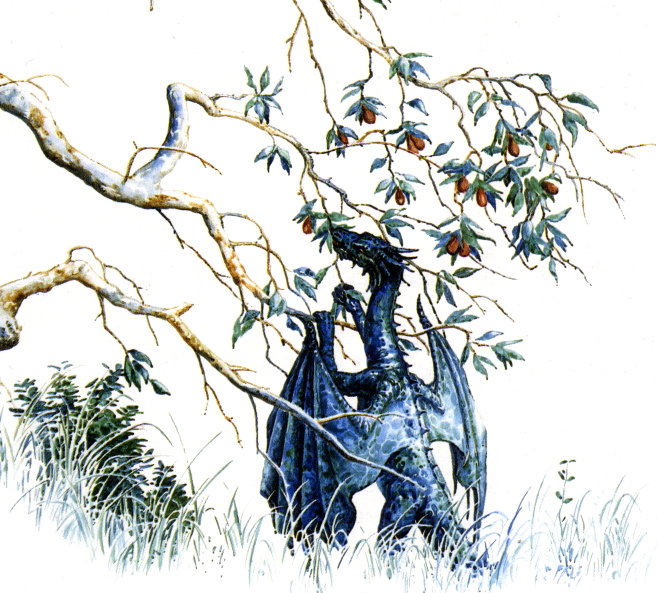
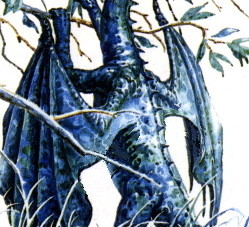
1. The wings are connected near the shoulder.
This is the most improbable type of wing. The surface is small near the body making the flight and even the glidding difficult, moreover the rear of the dragon tends to "fall" toward the ground. However, this disposition gives good results if the dragon is hovering.
|
|
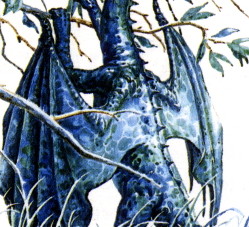
2. The wings are connected below the chest.
The wings as shown on the complete picture above is somewhat the mix between the situation 1 and 3. There is no real mistake here, except that situation 3 is better.
|
|
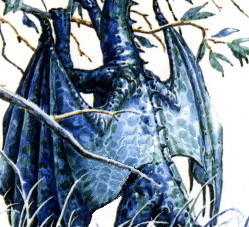
3. The wings are connected near the thighs.
This give a greater surface for the wings than the situation 1 and 2. The long neck and the tail give balance and enable the dragons to quickly gain or lose altitude. This is definitively the most probable type of wings.
|

Coloring

 It is impossible to list the enormous variety of hues that make up the dragon's brilliant coloring, but they can be divided into three broad color groupings: It is impossible to list the enormous variety of hues that make up the dragon's brilliant coloring, but they can be divided into three broad color groupings:
Blues, ranging from dark blue to silver and mother-of-pearl.
Red, ranging from copper-red to dark red and reddish-black.
Greens, which include every imaginable shade of green and yellow and even dark brown, emerald green and burnished gold.
Although these three principal color groups are not usually mixed, a dragon's coloring is rarely uniform. In general, his scales are several hues from one of the main color categories, with a metallic luster which is hard to define. When the scales have a pale, opaque appearance, it is a sure sign of ill health.
Many dragons are known by their scales, such as Ancalagon the Black, Smaug the Golden and Spars the Green.
|

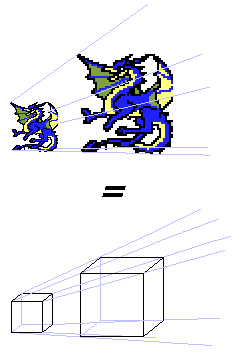
Dragons - David or Goliath?:
For many of you, the word "dragon" means huge, enormous or imposing creature but out of any reasonable doubts, the facts are different from the fairy tale. Dragons are probably small creatures (from 1 foot to 10 feet long). For this we need to look at fundamental principle of physics called "Physics of Proportion" or more commonly called "Physics of Lilliput".
First, you look at a cube (1cm x 1cm x 1cm) and you decide to double the length and you want to keep the proportion. You will have a bigger cube (2cm x 2 cm x 2cm). The length of the enlarged cube will be multiplied by 2, the surface will be multiplied by 4 and the weight/volume will be multiplied by 8. For example, let say that a bird needs to have a wing span equal to his body length to fly, enlarge this bird ten time. There will be 100 time more surface... However he will weight 1000 time more and since his wings give him the power to fly and that these rely on the surface and not on the volume, he will be unable to fly for his lack of lift power.
We have proof now that a large creature could have some difficulties to fly, but we haven't proof they cannot exist. The second thing is the structure of the dragon. Some persons send me theories that dragons could have cartilage instead of bones but this could only be possible in very small creature: The shark for example, live in water and in water your apparent weight is much lighter than in air that explain why an animal like this could live with only cartilage. Look at your nose and you ears, these are made in cartilage but as you have surely notice, this isn't very strong and it's could not support the weight of your entire body. Now if they cannot be made with cartilage, they are obviously made with flesh and bones but the fact with bone is that they rely on the surface (i.e. diameter and not surperficies) to be strong and large bone increase the mass and thus make the flight much more difficult.
This is more realistic to say that dragons are small creatures if you consider that they can fly otherwise, they will follow the same principle in the structures of these huge magnificient reptiles: the dinosaurs (in this case their wings would be absolutely useless).
(Summary of the "Physic of Proportion": The rule is simple, when you change an object proportionally, the change "A" affect the dimension as this: the length=A, the Surface=A2 and the Volume=A3. Eventually I will fully detail the effect of this physics principle... until this time, please bear with this present section...)
|

The Dragon's Eyes:
I think this point really needed to be cleared up since artistic representations and sciences occasionally do not mix very well. Dragons eyes are usually shown to be reptilian with a vertical slit for the pupil, while somewhere else you will have a round pupil and if you search hard you may even find dragon with insect-like eyes not to mention the "glow-in-the-darktm" eyes with no pupil at all.
In all these view about dragons (pun intended), what is possible and what is not, and more importantly: why?
The traditional (vertebrate) dragon eye:
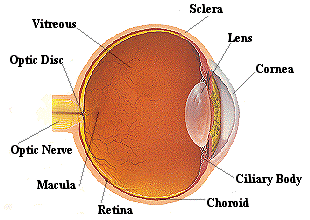
The eyes come in two flavors: with a round pupil or with a vertical slit. This is just a small detail because they both work the same way and they both have much in common with a standard camera. The light first pass through the cornea, the main source of refraction, then it pass through the lens which controls 1/3 of the refraction of light that enters the eye (the cornea, the other 2/3). Located just behind the pupil it allows for changing of focus from distance to near objects by altering its shape. This changing focus is called accommodation. As a person ages the lens hardens and accommodation becomes more difficult. Finally, the lights reach the retina that contains photoreceptors (rods and cones) that change light into sight by converting light into electrical impulses. These electrical messages are sent from the retina to the brain and interpreted as images. Simple heh?
The iris is the colored part of the eye has very fine muscles to control the size of the pupil and thus the intensity of the light (in conjunction with the eyelids). Being able to reduce the pupils to slits rather than tiny circles gives the creature a greater and more accurate control of how much light enters their eyes; this ability is particularly important in bright sunlight. Vertical slits also have an advantage over horizontal slits. When the creature's eyelids close at right angles to the vertical pupil, he can reduce the amount of light even further by bringing its eyelids closer and closer together. This combination of the vertical slits of the pupils and the horizontal slits of the eyelids, allows the creature to make the most delicate adjustments of the light reaching its eye compared to any other animal.
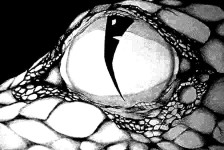
Also, many animals also have an additional structure called the tapetum - a reflective layer that lies under the retina and acts as a mirror, bouncing light back toward the retina a second time. Dogs, cats, horses, and cattle all possess them. This allows them to function under dim lighting better than humans. Cats, for instance, are five times better at detecting light than humans.
This is probably the most plausible situation, while is contain nothing new, this type of eyes has a long history of great functionally and an acceptable field of perception. However, this type of eyes possess only a 0.02 degree of visual range (i.e. there is only a small point in the picture where everything is clear. As you read this line, the paragraph above is blurred and cannot be read until you move the focus of your eyes on it).
Eyes made from a mosaic of lens (insect-like eyes):
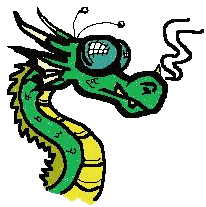
As opposite to the vertebrate eyes, the image is in fact many small "independant" units that will together form the image. Each small lens point toward a different direction and thus can view a wide angle. A vertebrate eye has 0.02 degree of visual range (ie where objects appear clear and sharp) but since each lens of the composite eye is relatively large, this eye has a poor visual acuity. The image is crude but still recognizable. However, the main reason why large creatures do not have composite eyes, it is because this type of eyes generally allows only a short range of vision. Flies and mosquitoes are very near-sighted, and can see only a few millimeters in front of them with any degree of resolution. Also, although the insect depth of focus is very short, it is nevertheless very broad. The near-sightedness of insects is so extreme that they see detail where we would need a microscope to see. On the other hand, in the human eye, the fovea, or area of sharpest focus, is only as big as our thumb.
|

Vertebrates
(humans for example)
| 
Composite eyes
(insects for example)
Each pixel is one of the several hundred lenses of the eye
|
As shown on the picture above, for a creature with composite eyes, the Earth still look like the old planet we still know but the details are poor. For an insect, the important point is probably to distinguish the flowers from the landscape and your hand (or predator) before you hit him. It is simple and well, it does the work for them but seriously, any large creature would be greatly disadvantaged by this type of eyes.
No slit at all; eyes appearing like a crystal ("crystalline" eyes)?
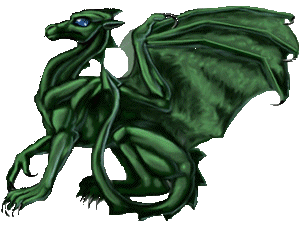 Think about the pernese dragons. How are they able to see something? In fact, the best explanation is there is no retina but instead the light receptors are distributed homogeneously in the eyes. This means a photoreceptor near the surface can see the object far away and you go deeper into the eyes, the photoreceptors are able to view objects that are closer. Think about the pernese dragons. How are they able to see something? In fact, the best explanation is there is no retina but instead the light receptors are distributed homogeneously in the eyes. This means a photoreceptor near the surface can see the object far away and you go deeper into the eyes, the photoreceptors are able to view objects that are closer.
This would also means that the eyes are always focused no matter the distance of the object (I admit this could seem very strange for most of us, but imagine a photo where the close objects are as sharp and crisp as the objects far away).
However, this do not give the same precision as a retina since the dragon cannot have a dense quantity of receptors without blocking the light; a dense quantity of cells would block the light for the layers deeper in the eye (to some extant, in fact, cells are almost totally transparent).
As said above, the advantage would be to be to always have the close and far object focused at the same time and having a great deep perception even with a single eye. I explain, for human and some other creatures having a binocular vision, this is extremely useful for evaluating deepness but if your eyes are focussed on every distance all the time and if your brain is able to tell which signals from which "layer" of photoreceptors, then the brain no longer need two eyes to know the "exact" distance between the creature and an object. This would allow the dragon to have his eyes slightly more on the side and have a greater angle of view without sacrificing their ability to determine deepness.
Another advantage would be to increase the angle of the eyes, bird have their eyes on each side and human right in front. We humans with our eyes squarely in the front of our heads, can see about 180 degrees, but we need to direct our eyes into the direction of the object to have a clear picture. The crystalline type of eyes would be focused not only for object of all range but also in all directions, this means once you come into their angle of vision, it is like if the dragon was looking directly at you all the time while we cannot describe very well a person standing in the corner of our vision.
The main disadvantage would be their inability to have one point where all their light receptors can be gathered. Owls for example have a very dense retina and this allow them to see small creatures (such as mice) even if they are very far from them. In a crystalline eye, this situation cannot exist, they can have a good visual acuity but not as high as the animals that are renown for their vision. Does this means a dragon with such eyes cannot have a great vision? Absolutely not, again, we humans have a vision angle of 180 degree and about 140 degrees of binocular overlap. Dragons with crystalline eyes could have an angle of vision around 220 degree (i.e. the eyes slightly on the side) and an overlaps of 110 degree. The object inside the overlapping degrees of both eyes would greatly increase the resolution of the object while the remaining angle of vision would be less defined (but much better defined than the visual acuity of the corner of our eyes). The degree where the vision of the dragon overlap would be equivalent to the area of sharpest focus and would be obviously much greater than our.
Glowing crystalline eyes?
Glowing eyes without slit are nonsense, I have see some trying to explain the phenomena but their explanation contain several flaws that make the theory highly questionable. Let face it, this is often used to show good/bad guys in manga and other cartoon but this remains very unrealistic. In fact, if the creature had an iris, it would be the reflection on the iris that would give the impression of glowing eyes. This is where the idea came from but as you all surely noticed, the "glowing" eyes of a cat in the dark do not really glow; it is just a reflection of the light. Now, imagine now that your pupil would glow, you would literally blind yourself by the light emitted but also by the reflection of this light back to you. The best example I can give is at night when you are inside your house, if you look outside with all the lamp turned on, the glass in the window will acts like mirror. In other words, if you need to look outside, it is easier when there is no light inside. Same thing for the eyes, if you have a light source inside the eye, this would 1) blind you by activating the photoreceptors around the light source, and 2) your own cornea would behave like a mirror and reflect you back the light you emitted thus blinding you even more. In a crystalline eye, the light emitted by the "crystalline" liquid would trigger photoreceptors that are surrounding the light source thus completely blinding the creature in the process.
All this to says, that artistically, this give dragons and fantastic look but scientifically there is so many problems generated by this type of eyes, that it would be a lot of trouble to gain no advantage over the other types of eyes...
|

Classification and Evolution:
Many can wonder in which class the dragons can be categorized. The dragons cannot be considerer as reptiles because they are active and they are warm blooded, and they cannot either be mammals [because they lay eggs (Monotrème like "Echiné à bec droit", are the only exeption to the rule because it are only the mammals to lay eggs) and they do not produce milk] and even less be birds (because they have scales and six members). However, the dragons have elements of each of these classes (reptiles, birds and mammals):
Birds: hollow bones, lay eggs Reptiles: lay eggs, have scales Mammal: four chamber heart, specialized teeth Unknown: six members (2 pair of legs/arms, one pair or wing) Thus, the dragons would be categorized in their own class... It would be a mistake to consider them in the current class because they do not answer the physical criteria requiered to belong to one or the other.
For their evolution, I would like first to put something at light: if you believe that the darwinism is only a theory, read this BEFORE contacting me by electronic mail for saying that it is only theory without good grounds.
Their evolution according to the most plausible assumption goes up with the first primitive reptiles, when those divides to follow different paths of evolution as to become the dinosaurs (which became the actual birds), the mammals and other better adapt reptiles. The dragons separate either from the dinosaurs or right before the mammal junction which gave some kind of reptile with mammal appearance (which look strangely close to a dragon without wings). With a few tens of a thousand of years of evolution, some beneficial mutations could have given them wings that have helped them to survive. This new branch in the evolution could explain the evolution of the dragons.
Note of the author: This section is still suject to discussion. Therefore, these informations are subject to change without notice.
|

Breath Weapon !?
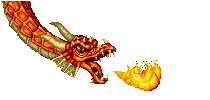 Fire Breather: Fire Breather:
The breath weapon of a dragon is not a magical thing that spread out of no-where but had a more scientific explanation. When we eat our body by digesting created a gas know as Methane (CH4), dragon unlike human and other animal store this gas into another kind of "lung" that will serve as a bag/canister to held the gas that will be later mixed with a small amount of phosphor (P4) that has the propriety to ignite in fire at the contact of air. When the dragon wants to breathe fire, the methane is release into the lung and when the gas is in the air, the phosphor ignites and also puts the methane in fire.
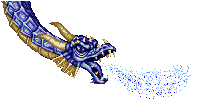 Cold/Frost Breather: Cold/Frost Breather:
Some dragons breathe a cone of frost, the explanation for this resides also in the food that the dragon ingests. The food is break down into the stomach primary for nutrition but the remain bear some chemicals reactions that will give a gas, I suppose to be Nitrogen (N2) (I have not yet found the exact composition of it but I continue to work hard to find the most probable natural refrigeration gas), the gas is compress by extremely strong muscles, exactly alike the base system of a refrigeration system, the dragon doesn't need to thing for it because it is spontaneous and painless. When a dragon needs to freeze an opponent, the highly compressed nitrogen, that almost reach the liquid state, is release in the lungs and when the gas comes into air, it uncompresses at an unimaginable speed. That result in the gas absorbs all the heat in is environment. This cause the temperature in the breath to drop to an average of -50 °C (more test had to be made to know a more exact °T), anyone caught in the path of the breath without heavy heat protection are at least seriously injured and only death remain for the weaker one.
It may have another explanation that can be explain by extremely efficient and fast oxidation-reduction reactions but we will not explain it much (everyone who has done is advanced inorganic chemistry should understand the concept otherwise you should review or have listen your college class)
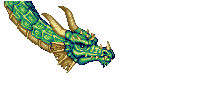 Acid Breather: Acid Breather:
For other breath weapon least know follow the same principle and don't need much detail about them.
I made one observation during my research: it seems to have a direct link between the breath and the food, if a dragon is starving his breath weapon doesn't regenerate. All the incredible system of dragon makes it the most fascinating creature in the know universe.
|

Reproduction
The reproductive system of these creatures is internal, it means that at the look of their external physiognomy, it is hard (not to say nearly impossible) to determine if this dragon is a male or a female, only the general behavior and the small change in their color can provide informations about the dragon's gender. Dragons lead egg like reptiles and bird, eggs are protected by a hard shell that with time will weaken to let the new baby dragon break it more easily. The incubation period of these creatures is mostly unknown; some egg will hatch in a year other two and some more than five year. The dragons eggs are rich in calcium and I suppose that the newborn dragons eat is shell to not waste the nutriment in it.
The mating process is known as dragon-slide: the two partners fly high in the sky and after a moment they grab each other and close their wing and make free-fall. Then at less than a hundred feet from the ground they open their wing and land. The dragons so unusual mating process is mainly because dragons love speed and risk, and add these to the pleasure of love... you have a sensation that human could never enjoy. (Too bad, you should have born dragon).
|

Society
There is currently no way to tell what kind of organization or type of society about dragons. Legends and lores often say that dragons tend to be loner by nature or by obligation. According to these legend, dragons pass much of their time alone in their lair, they, during this time, learn about their environment and how to use it wisely. Because they are alone a great deal of time, most of them enjoy company of other dragons and even human as long as they hadn't come in the goal of stealing or conquest. It may be possible that dragons have some sort of council leaded by an elderly dragon but this yet has to be proven.
|

Dragons and Mankind
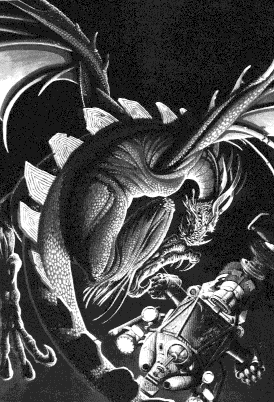 Throughout history dragons and human beings have been unable to live peacefully side by side. As a result, mankind has not been able to benefit from ancient dragon knowledge. Throughout history dragons and human beings have been unable to live peacefully side by side. As a result, mankind has not been able to benefit from ancient dragon knowledge.
Man's craving for power and religious beliefs have kept Europe engulfed in interminable and bloody struggles. The dragon lords could not understand the reasons for man's self-destructive behavior, and kept well out of the way, retreating to remote hiding places far from all this confusion.
Shrouded in mystery, the dragon's trail remained lost in the obscurity of legend.
However, the dragons secretly pursued their quest for knowledge without completely excluding the human race, since they accepted and taught those few men who sought the essence of truth.
We could wonder what would happen if the dragons reveal themselves to the eyes of the humankind... Would we be able to accept another form of intelligence probably far superior to our or would we feel the need to fight those, who at the end, could come to our rescue, and this under the only pretense that these beings make umbrage to us...?
|

Art and Jewels
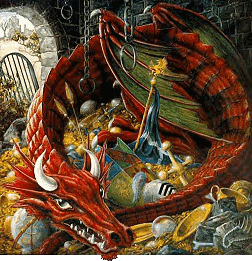 The dragon is a great lover of art, especially of gold and silver, and work, and he loves to hoard treasure. However, he is not renowned for his love of manual work, preferring intellectual activity by far. That is why he does not devote himself to creating jewels, but only to "acquiring them" from human beings through various methods. Robbery, looting, trade, barter, fraud - by any means fair or foul which enables him to come by the jewels and precious stones he covets.
The dragon is a great lover of art, especially of gold and silver, and work, and he loves to hoard treasure. However, he is not renowned for his love of manual work, preferring intellectual activity by far. That is why he does not devote himself to creating jewels, but only to "acquiring them" from human beings through various methods. Robbery, looting, trade, barter, fraud - by any means fair or foul which enables him to come by the jewels and precious stones he covets.
The dragon feels he never has enough jewels and he finds it difficult to part voluntarily with a single one of his treasures. Even though, for example, he gives jewels to the favorites in his family, he does it purely because he knows that the young maidens cannot remove the jewels to the outside world. He is very jealous of his belongings and guards the treasure he has built up over the years in large storerooms. He keeps detailed inventories of all his possessions so that he can be alerted immediately if a single object goes missing.
Jewels serve a specific purpose for the dragon in that he usually sleeps on a bed of gems and luxurious fabrics, such as silks and velvets. For this bed, he never uses soft stones like pearls and emeralds, as they are too fragile.
Another theory says that dragons also hoard "precious" items for reasons other than just simple obsession. At a level we humans are incapable of feeling, different metals and other items "resonate" at certain levels, especially gold and silver. The dragons could use this resonation to their advantage, controlling it, manipulating it. In a nut shell, it enhanced their already remarkable "mystic" powers.
In addition to the enhancing powers, this "resonation" also had the same addictive effect as a "rush" in humans. Hence, the more a dragon acquired, the more he/she wanted. This also allowed their immediate detection of any missing piece.




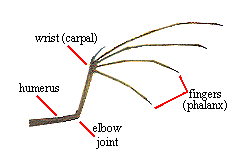
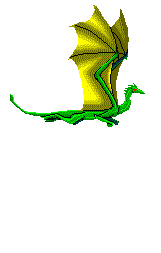
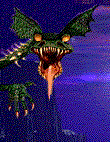








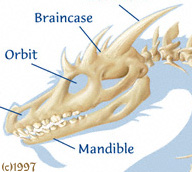
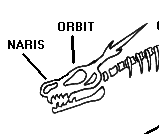
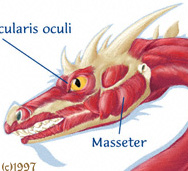
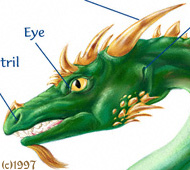








 Fire Breather:
Fire Breather: Cold/Frost Breather:
Cold/Frost Breather: Acid Breather:
Acid Breather:


0 comments:
Post a Comment